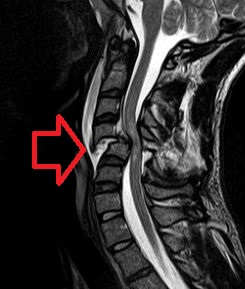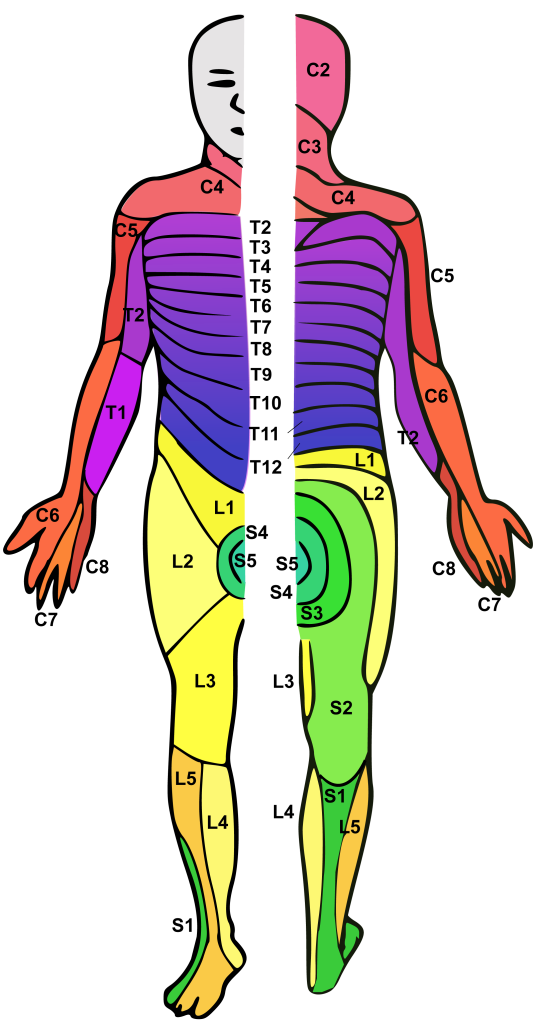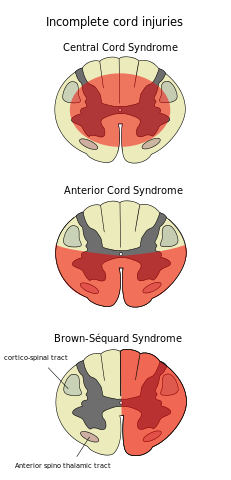Spinal Cord Injuries
Published .

Introduction
Spinal cord injury (SCI) is a serious medical condition, which often results in severe morbidity and permanent disability. It occurs when the axons of nerves running through the spinal cord are disrupted, leading to loss of motor and sensory function below the level of injury. Injury is usually the result of major trauma, and primary injury is often irreversible. These injuries are particularly costly and disabling as they disproportionately affect patients under 30-years-old, lead to significant functional impairment for the remainder of the individual’s life, and put the individual at risk for numerous complications leading to increased morbidity and mortality. SCI is estimated to have a lifetime economic impact of 2 to 4 billion dollars.
Etiology
Within the United States, the leading cause of spinal cord injury is motor vehicle collisions, constituting 38% of new SCI each year. 30% are due to falls, 13% due to violence, 9% from sports injuries, and 5% from medical and surgical etiologies.
Epidemiology
Globally, between 250,000 and 500,000 patients, each year suffer a spinal cord injury. Most of these cases are due to preventable causes such as violence and motor vehicle accidents. In the United States, there are approximately 17,000 new cases of SCI each year, and roughly 282,000 persons are estimated to be living with SCI. Males represent the majority of patients with SCI related to a sports injury. The age group with the highest risk of SCI is from 16 to 30 years of age.
Pathophysiology
Spinal cord injuries are most often due to either direct trauma to the spinal cord or from compression due to fractured vertebrae or masses such as epidural hematomas or abscesses. Less commonly, the spinal cord may become injured due to compromise of blood flow, inflammatory processes, metabolic derangements, or exposure to toxins.
Primary Injury
SCI results from initial insult such as mechanical forces to it, which is known as the primary injury. The most common mechanism of primary injury is a direct impact, and persistent compression typically occurs by bony fragments through fracture-dislocation injuries. Contrary to fracture-dislocation, hyperextension injuries usually result in less frequent, impact alone plus transient compression. The third mechanism, distraction injury, a stretch and tear of the spinal cord in its axial plane, occur by pulling apart of two adjacent vertebrae. Lastly, laceration/transection injury, which arises through sharp bone fragments, severe dislocations, and missile injuries.
Secondary Injury
Secondary injury is a series of biological phenomena that begins within minutes and continue to self-immolation for weeks or months following the initial primary injury. The acute phase of secondary injury begins after SCI and involves vascular damage, ionic imbalances, free-radical formation, the initial inflammatory response, and neurotransmitter accumulation (excitotoxicity). The subacute phase follows, which includes demyelination of surviving axons, Wallerian degeneration, matrix remodeling, and formation of the glial scar.
History and Physical

Typically patients will present after a significant traumatic event such as a motor vehicle accident, fall from a height, or gunshot wound. Vitals are unlikely to be abnormal, although high cervical injuries can result in hypotension and bradycardia due to loss of sympathetic tone. The physical exam will reveal weakness and sensory deficits correlating to the pattern of injury, and the spinal tracts affected. Several classic patterns of injury are well described.
Complete Transection of the Spinal Cord
- These injuries typically demonstrate complete bilateral loss of motor function, pain sensation, temperature sensation, proprioception, vibratory sensation, and tactile sensation below the level of injury.
- Lumbosacral injuries will present with paralysis and loss of sensation in the lower extremities. These injuries may also result in loss of bowel control, loss of bladder control, and sexual dysfunction.
- Thoracic injuries lead to the same deficits as lumbosacral injuries and, in addition, may result in loss of function of the muscles of the torso, leading to difficulty maintaining posture.
- Cervical injuries lead to the same deficits as thoracic injuries and, also, may result in loss of function of the upper extremities leading to tetraplegia. Injuries above C5 may also cause respiratory compromise due to loss of innervation of the diaphragm.

Central Cord Syndrome
- This is the most common incomplete SCI.
- Injury is caused by hyperextension of the neck leading to compression of the cervical spinal cord, causing damage primarily to the center of the cord.
- This pattern of injury leads to weakness affecting the upper extremities more so than the lower extremities. This pattern occurs as the corticospinal tracts are arranged with those axons supplying the upper extremities located closer to the center of the spinal cord, while those supplying the lower extremities are closer to the periphery.
- There may also be an associated loss of pain and temperature sensation below the level of injury.
Anterior Cord Syndrome
- Classically due to compromise of blood flow from the anterior spinal artery.
- Bilateral injury to the spinothalamic tracts leads to bilateral loss of pain and temperature sensation below the level of injury.
- Bilateral injury to corticospinal tracts leads to weakness or paralysis below the level of injury.
- As dorsal columns are unaffected, tactile sensation, proprioception, and vibratory sensation remain intact.
Posterior Cord Syndrome
- This injury pattern rarely occurs due to trauma. More often, injury is due to infectious, toxic, or metabolic causes.
- Damage to dorsal columns causes loss of tactile sensation, proprioception, and vibratory sensation.
- As spinothalamic and corticospinal tracts are unaffected, there is the preservation of pain sensation, temperature sensation, and motor function.
Brown-Séquard Syndrome
- Injury results from right or left-sided hemisection of the spinal cord.
- Transection of the corticospinal and dorsal column nerve tracts leads to ipsilateral loss of motor function, tactile sensation, proprioception, and vibratory sensation below the level of injury.
- Transection of the spinothalamic tract leads to contralateral loss of pain and temperature sensation below the level of injury.
Conus medullaris Syndrome
- It is caused by injury to the terminal aspect of the spinal cord, just proximal to the cauda equina.
- It characteristically presents with loss of sacral nerve root functions. Loss of Achilles tendon reflexes, bowel and bladder dysfunction, and sexual dysfunction may be observable.
Neurogenic Shock
- It results from high cervical injuries affecting the cervical ganglia, which leads to a loss of sympathetic tone.
- Loss of sympathetic tone results in a shock state characterized by hypotension and bradycardia.
